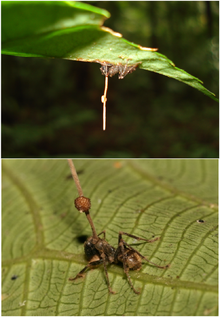Ophiocordyceps
| Ophiocordyceps | |
|---|---|

| |
| Dead ants infected with Ophiocordyceps unilateralis | |
| Scientific classification | |
| Kingdom: | Fungi |
| Division: | Ascomycota |
| Class: | Sordariomycetes |
| Order: | Hypocreales |
| Family: | Ophiocordycipitaceae |
| Genus: | Ophiocordyceps Petch (1931) |
| Type species | |
| Ophiocordyceps blattae (Petch) Petch (1931)
| |
| Synonyms[1] | |
|
Cordycepioideus Stifler (1941) | |
Ophiocordyceps is a genus of fungi within the family Ophiocordycipitaceae.[2] The widespread genus, first described scientifically by British mycologist Tom Petch in 1931,[3] contains about 140 species that grow on insects.[4] Anamorphic genera that correspond with Ophiocordyceps species are Hirsutella, Hymenostilbe, Isaria, Paraisaria, and Syngliocladium.[5]
One species complex, Ophiocordyceps unilateralis, is known for its parasitism on ants, in which it alters the behavior of the ants in such a way as to propagate itself more effectively, killing the ant and then growing its fruiting bodies from the ant's head and releasing its spores.[6][7][8] A 48-million-year-old fossil of an ant in the death-grip of Ophiocordyceps unilateralis was discovered in Germany.[9]
Species[]
This section does not cite any sources. (November 2020) |
- Ophiocordyceps arborescens
- Ophiocordyceps amazonica var. neoamazonica
- Ophiocordyceps camponoti-balzani
- Ophiocordyceps camponoti-melanotici
- Ophiocordyceps camponoti-novogranadensis
- Ophiocordyceps camponoti-rufipedis
- Ophiocordyceps coenomyia
- Ophiocordyceps cucumispora var. dolichoderi
- Ophiocordyceps formicarum
- Ophiocordyceps kniphofioides var. dolichoderi
- Ophiocordyceps kniphofioides var. monacidis
- Ophiocordyceps kniphofioides var. ponerinarum
- Ophiocordyceps lloydii var. binata
- Ophiocordyceps macroacicularis
- Ophiocordyceps melolonthae var. rickii
- Ophiocordyceps myrmecophila
- Ophiocordyceps nutans
- Ophiocordyceps owariensis f. viridescens
- Ophiocordyceps purpureostromata f. recurvata
- Ophiocordyceps robertsii - Vegetable caterpillar, āwheto
- Ophiocordyceps sinensis - Caterpillar fungus, chong cao
- Ophiocordyceps sphecocephala
- Ophiocordyceps superficialis f. crustacea
- Ophiocordyceps unilateralis
- Ophiocordyceps unilateralis var. clavata
See also[]
References[]
- ^ "Ophiocordyceps Petch 1931". MycoBank. International Mycological Association. Retrieved 2011-07-19.
- ^ Lumbsch TH, Huhndorf SM (December 2007). "Outline of Ascomycota – 2007". Myconet. Chicago, USA: The Field Museum, Department of Botany. 13: 1–58.
- ^ Petch T. (1931). "Notes on entomogenous fungi". Transactions of the British Mycological Society. 16 (1): 55–75. doi:10.1016/S0007-1536(31)80006-3.
- ^ Kirk PM, Cannon PF, Minter DW, Stalpers JA (2008). Dictionary of the Fungi (10th ed.). Wallingford, UK: CABI. p. 483. ISBN 978-0-85199-826-8.
- ^ Sung G-H, Hywel-Jones NL, Sung J-M, Luangsa-ard JJ, Shrestha B, Spatafora JW (2007). "Phylogenetic classification of Cordyceps and the clavicipitaceous fungi". Studies in Mycology. 57: 5–59. doi:10.3114/sim.2007.57.01. PMC 2104736. PMID 18490993.
- ^ Bhanoo SN (24 August 2010). "In Fossilized Leaf, Clues to a Zombie Ant". The New York Times.
- ^ Zimmer C (24 October 2019). "After This Fungus Turns Ants Into Zombies, Their Bodies Explode". The New York Times.
- ^ Evans HC, Elliot SL, Hughes DP (March 2011). "Hidden diversity behind the zombie-ant fungus Ophiocordyceps unilateralis: four new species described from carpenter ants in Minas Gerais, Brazil". PLOS ONE. 6 (3): e17024. Bibcode:2011PLoSO...617024E. doi:10.1371/journal.pone.0017024. PMC 3047535. PMID 21399679.
- ^ Hughes, David P.; Wappler, Torsten; Labandeira, Conrad C. (2011-02-23). "Ancient death-grip leaf scars reveal ant–fungal parasitism". Biology Letters. 7 (1): 67–70. doi:10.1098/rsbl.2010.0521. PMC 3030878. PMID 20719770.
External links[]
 Media related to Ophiocordyceps at Wikimedia Commons
Media related to Ophiocordyceps at Wikimedia Commons
- Hypocreales genera
- Ophiocordycipitaceae
- Parasites of Hymenoptera
- Taxa described in 1931